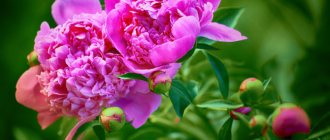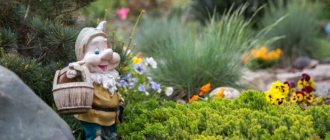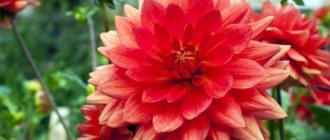Many gardeners grow this amazing flower in their flower beds. If you look at different photos of dahlia, you will notice that the plant has a wide range of colors and a variety of shapes. These flowers can become a decoration for any garden plot. To get lush bushes, you should know how to grow them.
The dahlia, which was brought to European countries from Mexico back in the 17th century, looks bright in flower beds. The name of the plant was given in honor of the famous ethnographer Johann Georgi. The German scientist worked and lived in St. Petersburg.
The huge variety of forms of this flower is amazing. It is used for borders and used as single plants. Elegant flowers in flower beds look amazing.
Features of cultivation
These flowers delight us with their dazzling beauty. They do not require special care; even novice gardeners can grow them. There are several ways to propagate this amazing flower. It can be planted by seeds, cuttings, or by dividing tubers.
Any soil is suitable for these plants; they are watered infrequently, but abundantly. Dahlia loves sunny, spacious areas; it also grows well in partial shade. The plant should not be planted in places where there is a draft and there is an excess of moisture. The flower is afraid of cold weather, so planting is carried out when the threat of frost has already passed.
The soil is dug up in the fall, and the soil is well fertilized to provide the future plant with all the necessary nutrients. With the arrival of spring days, the selected area is dug up, and gardeners add bone meal to the soil.
This flower is not grown in areas where asters previously grew. It is also better not to plant them where there are plants that are infected with fungus. Dahlias can also suffer from this disease.
If the time has come for planting, the tubers are divided. To separate, use a knife to separate the tuber. This is a simple and commonly used method of propagation. This operation can be repeated if the size of the planting material allows this. The cut areas are treated with potassium permanganate, brilliant green or crushed coal.
After this, they must be dried. Dry roots are removed using pruning shears; damaged parts should be treated with brilliant green. Then the dahlias are planted in pots or open ground. The distance between holes must be at least 0.5 m.
Planting dahlia directly into the soil is possible if it has completely warmed up. Then the plant will not suffer from the cold. If you purchase a tall variety, you should take care of support in advance.
Diseases
Gray rot is considered the most common nuisance; it appears as a result of excessive watering or excess nitrogen.
Symptoms of the development of the disease will be a gray coating on the buds, crooked flowers or brown spots. Effective treatment will be rapid removal of the affected areas.
The second disease is fusarium and white rot. High-quality culling of roots before planting, timely and rather ruthless removal of diseased plants will help to avoid such problems.
Caring for dahlias
The flower must be watered systematically. The soil should be moistened to a depth of 30 cm. Increased humidity can lead to the death of the plant. Feeding is carried out every two weeks so that the plant develops well.
After the sprouts appear, you need to water them with manure, which is diluted with water 1:10. If the long-awaited buds appear on the plant, you should apply fertilizers that include potassium and superphosphate. If the soil was well fertilized before planting, then fertilizing may not be necessary.
The flowers have a fragile stem that can break in windy weather. To avoid this trouble, it is better to tie up the plant. The support can be wooden or metal pegs. This is taken care of even when planting the plant.
Pruning is necessary to obtain large buds. No more than 2 buds are left on one peduncle. Fading heads should be removed immediately so as not to inhibit the development of new flowers.
The flower is susceptible to many diseases; various pests can also harm it. You can protect the shoots using special products that are easy to purchase in specialized stores.
Watering
Humidity will become almost the only requirement when deciding how to plant dahlias.
Seedlings and tubers will require a drainage layer of gravel, brick, and pebbles to remove excess moisture. After each rain, it is better to loosen the soil so that the water does not stagnate.
Flower clocks - designer tips, methods of use and original ideas for flower clocks (105 photos + video)- Low-growing flowers - types, descriptions and ideas for use in landscape design (100 photos and videos)
Flowers for a flower bed - basic design rules and ideas for creating the perfect flower garden (110 photos and videos)
Watering must be moderate so that the tubers do not rot.
Tuber storage
Dahlia does not tolerate low temperatures, so its tubers are dug up for the winter. In spring, the plant is planted again in the ground. You need to dig up tubers in the fall carefully so as not to damage them. After completing this procedure, the tubers are cleared of soil, and small roots are removed.
You can rinse the dug planting material under a slight pressure of water. Afterwards it is dipped into a weak solution of potassium permanganate. This is done to clean the tubers from harmful microorganisms.
Then they are dried in the sun or brought into a warm room, sprinkled with sawdust and placed in boxes. The best temperature for storing dahlias is 3-5 °C.
Usage
Most often, perennial and annual dahlias are used as decoration for gardens, alleys, and flower beds.
The varieties of lovely flowers are so diverse that they adorn the exquisite creations of landscape designers, the ordinary flower beds of an ordinary owner of a country house, and even well-groomed flower beds near apartment buildings. Moreover, the question of how to plant dahlias will not become too difficult to resolve.
But the same Aztecs used dahlias as components for medicines, used them as an edible product, and made smoking pipes.
Variety of varieties
Flowers are distinguished depending on their shape and the structure of the inflorescences. The most popular varieties of dahlias:
Simple flowers with one row of petals Yellow Hammer, Princess Marie Jose, Orangeade.
Anemone-like plants will become a bright accent in the garden. Plain types are common, as well as varieties with a core painted in a contrasting color.
Collared dahlias are especially popular in France. Their inflorescences consist of large reed flowers, the outer petals of which are painted a different color.
The peony type is distinguished by semi-double inflorescences with two or more rows of petals located around a yellow core.
Decorative dahlias have wide wavy petals; they will give the flowerbed an extravagant look.
Today there are many varieties of these flowers. Among the huge assortment, you can find the right type that will occupy a special place in the flowerbed, complement the composition, make it more expressive and attractive.
A little history
Perennial dahlias are native to Mexico. They are considered the national symbol of this country and have long been an artifact of the Aztecs.
Mexican legends claim that the luxurious flower lived only in the royal garden for a long time, and only crowned heads could enjoy its charming appearance. But one day a loving gardener stole a blossoming bud and gave it to his bride. The girl was so amazed by the unusual petals and wonderful shades of the flower that she agreed to the marriage. And as a wedding gift she asked for the root of the plant. So the lovely flower got out into the wild.
Dahlias have a second name, little known even to advanced gardeners: Dali. Both names are associated with prominent botanists. In Russia, plants are often named in the feminine gender.
Photo dahlia
Collar
The subspecies received its name due to the special arrangement of the flower petals. They are large at the edges and smaller closer to the center, usually of a different color. The height of the bushes reaches 120 cm.
The Impression Fabula variety is distinguished by its short stature. Its height is no more than half a meter. Prefers bright sunny places.
The Collarette Dandy color mixture blooms for a very long time - from the beginning of July to the end of October.
The Night Butterfly variety is two-colored and looks beautiful in bouquets.
The Pooh variety is unpretentious to wintering conditions.
The Jocondo variety has particularly brightly colored flowers.
Cactaceae
Fringed Star
| |
Friguolet
|
Reviews from flower growers
VEP
Akita is red with a yellow base. And Rebecca World cannot be identified with one photograph - all the flowers on the bush are different
Source: www.forumhouse.ru
Topolek
I planted Art Deco from dahlias Gelleri in the ground - I really liked it, it bloomed all season from June to November as a large beautiful bush, about 50 cm.
Source: flower.wcb.ru
Pompons
Little Robert
| |
Deepest Yellow
|
Decorative
Dahlias of this species have the largest inflorescences - up to 40 cm in diameter. The height of the bush reaches 2 meters.
The Melody Dixie variety is distinguished by flowering until frost.
The “duet” variety is distinguished by lush flowering and resistance to frost.
The Santa Claus variety is very bright, the flowers are large, the height of the bush is up to one and a half meters.











